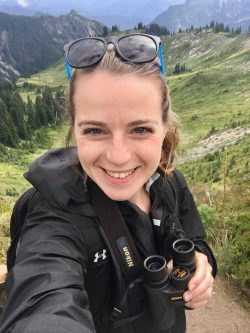
The predictable, daily routines of humanity have all but stopped with the arrival of COVID-19. For most of us, we no longer head to the office each morning or have friends and family over for dinner in our homes. Our day-to-day activities now look entirely different than they did six weeks ago.
But does this abrupt change only apply to us bi-pedaled mammals? What about other animals, like our neighborhood populations of birds? Are our feathered friends feeling this change too? And does it drive them to go about their lives differently?
That question is top of mind for Olivia Sanderfoot, a graduate student in Dr. Beth Gardner’s lab in the School of Environmental and Forest Sciences. Sanderfoot studies the effects of air quality on birds, specifically air pollution that comes along with wildfires, but her upcoming field season in Eastern Washington is now on hold. Yet amidst the upheaval of this pandemic, Sanderfoot saw an opportunity emerge right at her doorstep. In fact, she saw that opportunity emerge at all of our doorsteps—and she’s looking for you to help.
“I was thinking about how to use my time, and how air pollution in our cities must be changing right now,” says Sanderfoot. “I thought with social distancing and refraining from nonessential travel, there will be fewer vehicles on the road, which means less health-damaging air pollution and road noise. And that could be beneficial to birds.”
Fast forward two weeks, and Sanderfoot and her colleagues have developed a study to get at questions surrounding bird behavior during coronavirus. They launched a community science project aimed at monitoring birds in urban and suburban neighborhoods across the Pacific Northwest, while social distancing measures are currently in place.
“So far, we have over 290 people signed up to help collect data!” says Sanderfoot. The more volunteers she gets, the stronger the research will be.
The project helps novice and seasoned birders alike track birds and their behavior during this sudden change, now through June 30. Participants are asked to go to their backyard or their local green space—observing social distancing rules, of course—and record all the birds they see or hear for ten minutes, at least once a week. Sanderfoot will ask volunteers to also collect the same data next year if they can, when presumably the world will look more normal as social distancing measures are eased. Comparing multiple years gives researchers insights into how and if the coronavirus had an effect on birds.

“Right now, you’ll see lots of American robins, American crows, song sparrows, dark-eyed juncos. The yellow-rumped warbler is in its breeding plumage right now, so it’s easy to spot,” says Sanderfoot. “There are lots of great backyard birds in Seattle.”
Researchers are looking to answer questions like: are bird species using habitats they typically do not? Does noise have an effect on our ability to hear birds? Does noise impact a bird’s ability to hear and call to others? to list a few. All observations are important, whether from an apartment balcony overlooking an alleyway, a backyard filled with native plants and abundant flowers, or a local greenspace or micropark. “The greater the variety of habitat you have near you the greater number of observed species.”
Sanderfoot notes another important aspect of this project is to give people a meaningful connection to nature during a time of isolation. More and more, researchers realize that human well-being benefits from time spent outdoors, and participating in surveying birds can fill that gap. And it seems that people are eager to help Sanderfoot. “The response has been a bright spot for me during this challenging time,” she says.
Sanderfoot wants to emphasize that participating in this project is not just for the lifelong bird enthusiast. She and her colleagues invite novice birders to join in and learn the ropes. “Lots of new birders are excited and have signed up. They are looking for something to do that is constructive and insightful during this unprecedented time, and we are here to help people build up their birding skills. As long as you’re putting in the effort and trying your best, we are happy to have you involved!”
Check out Sanderfoot’s 2020 Year End Report on monitoring birds.
How to get involved
To learn more about this project and how to get involved, check out eBird Northwest’s Impact of Social Distancing on Bird Activity.
You can also email Olivia Sanderfoot directly: oliviavs@uw.edu
More on this story and backyard birding
Trapped at home? You can help UW study bird responses to social distancing
A new study aims to learn the impacts of social distancing on birds in the Pacific Northwest
Birdwatching from your own window perch

